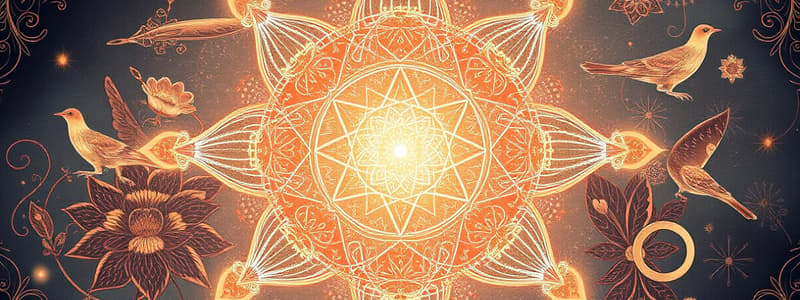Podcast
Questions and Answers
What is chemistry the study of?
What is chemistry the study of?
Atoms and elements
How many elements occur naturally?
How many elements occur naturally?
92
What are the four types of bonds or interactions?
What are the four types of bonds or interactions?
- Hydrogen bonds (correct)
- Covalent (correct)
- Van der Waals interactions (correct)
- Ionic (correct)
An atom that contains equal numbers of protons and electrons is called an ion.
An atom that contains equal numbers of protons and electrons is called an ion.
What type of bond is formed between ions with opposite charges?
What type of bond is formed between ions with opposite charges?
What are cations?
What are cations?
What are anions?
What are anions?
What are the two types of covalent bonds?
What are the two types of covalent bonds?
In a polar covalent bond, electrons are equally shared by the atoms.
In a polar covalent bond, electrons are equally shared by the atoms.
Flashcards are hidden until you start studying
Study Notes
Chemistry of Life
- Chemistry involves the study of atoms and elements, serving as fundamental to understanding biological processes.
- Matter consists of elements, which cannot be chemically broken down into simpler substances.
- There are 118 defined elements, with 92 occurring naturally and fewer than 30 present in living cells.
- 26 elements are unstable or theoretical and have not been detected.
Atoms
- Atoms are the smallest units of an element, retaining all chemical properties of that element.
- Electrons, protons, and neutrons are the primary subatomic particles in atoms.
- Neutral atoms have equal numbers of protons and electrons; an unequal number results in ions.
Chemical Bonds
- Atoms form chemical bonds to achieve a stable, low-energy state.
- Types of chemical bonds include:
- Ionic bonds
- Covalent bonds
- Hydrogen bonds
- Van der Waals interactions
Ionic Bonds
- Formed between ions of opposite charges through the transfer of electrons.
- Positive ions (cations) result from losing electrons, while negative ions (anions) result from gaining electrons.
- Example: Sodium (Na) donates one electron to Chlorine (Cl), resulting in Na⁺ and Cl⁻ ions.
Covalent Bonds
- Formed when electrons are shared between atoms, making them the strongest and most prevalent bonds in living organisms.
- Two types of covalent bonds:
- Polar covalent bonds: Electrons are unequally shared, spending more time near one atom.
- Nonpolar covalent bonds: Electrons are equally shared between same-type atoms.
Studying That Suits You
Use AI to generate personalized quizzes and flashcards to suit your learning preferences.




